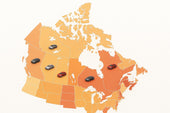Canada's EV rebate system has changed significantly. The federal iZEV program, which provided rebates up to $5,000 for electric vehicles (EVs), ended on January 12, 2025, after running out of funds. The November 2025 federal budget gave no indication of its return. EV sales have dropped sharply, with a 30% decline nationwide and a 65% drop in Quebec's first-quarter EV sales.
Without federal rebates, provincial programs are now the main way to save on EV purchases. However, these programs vary by province in terms of rebate amounts, eligibility criteria, and expiry dates. For example:
- Prince Edward Island: Up to $5,750 for new EVs, $3,250 for hybrids, and rebates for used vehicles.
- Quebec: Up to $4,000 for new EVs and $2,000 for used EVs.
- British Columbia: Income-based rebates up to $4,000.
Some provinces, like Alberta and Saskatchewan, no longer offer rebates since they relied solely on federal incentives. Meanwhile, programs in other regions, such as New Brunswick, have already ended.
With many provincial rebates set to phase out by 2027, timing and location are key for buyers. Platforms like Price Driven can help you save through dealer discounts as rebates become less reliable. EV buyers must act quickly and stay informed as Canada aims for 100% zero-emission vehicle sales by 2035.
1. Federal EV Rebates
Rebate Amounts
The iZEV program provided rebates of up to $5,000 for eligible battery electric and hydrogen fuel cell vehicles, while select plug-in hybrids qualified for rebates between $2,500 and $5,000. In provinces like Quebec, these federal incentives could be combined with provincial rebates, allowing buyers to save up to $12,000 before the program was paused. For commercial buyers, the Incentives for Medium- and Heavy-duty Zero-Emission Vehicles (iMHZEV) program offered rebates of up to $200,000 per eligible vehicle.
Program Expiry Dates
The iZEV program officially paused on January 12, 2025, after funds ran out - three weeks earlier than its planned end date. As of November 2025, there are no federal consumer EV rebates, and the 2025 federal budget did not include any plans to reinstate the program. On the other hand, the commercial iMHZEV program is still active and will continue until the end of the 2025–2026 fiscal year.
Eligibility Requirements
To qualify for the iZEV rebate, vehicles had to meet specific criteria. They needed to be new, appear on the official list of eligible models, and be purchased or leased from an authorized Canadian dealer. Price limits were also in place: base models had to have an MSRP of $55,000 or less, and higher trims could not exceed $65,000 - a restriction that excluded many luxury vehicles. Buyers who ordered an eligible vehicle before January 12, 2025, but had not yet received it, were encouraged to confirm that the rebate was applied at the point of sale.
Stackability
One of the standout features of the iZEV program was its ability to be combined with provincial rebates. This allowed buyers in provinces with their own EV incentive programs to significantly increase their savings. For example, stacking federal and provincial rebates previously enabled total savings of nearly $12,000. However, with the federal program on pause, only commercial buyers can still combine these business-focused incentives with provincial rebates until the iMHZEV program wraps up in 2026.
For Canadian EV buyers now navigating the market without federal support, platforms like Price Driven offer a way to save through transparent invoice pricing and pre-negotiated dealer discounts. Up next, we’ll explore the provincial rebate programs that have become essential for maximizing savings.
Where can you still find the biggest EV rebate in Canada?
2. Provincial EV Rebates
With federal incentives currently on hold, provincial rebates play a key role in determining how much you can save on an electric vehicle (EV). The rebate amounts, eligibility criteria, and timelines vary significantly across provinces, so it’s important to know what’s available in your region.
Rebate Amounts
The size of provincial rebates depends on where you live. Prince Edward Island offers some of the most generous rebates, with up to $5,750 available for new battery electric vehicles and $3,250 for plug-in hybrids. These same amounts also apply to used vehicles priced under $70,000.
In Québec, the Roulez vert program provides up to $4,000 for new battery electric or fuel cell vehicles priced below $65,000. Plug-in hybrid buyers can receive between $1,000 and $2,000, depending on the model. For used battery electric vehicles purchased from licensed dealers, Québec offers a rebate of $2,000.
British Columbia's CleanBC Go Electric program adjusts rebate amounts based on household income, with rebates reaching as high as $4,000 for eligible vehicles. Meanwhile, Manitoba also has an active rebate program, but buyers should check the provincial website for the most up-to-date information.
Some provinces, like New Brunswick, previously offered combined provincial and federal incentives of up to $10,000, but those programs have since ended. Provinces such as Alberta and Saskatchewan depend solely on federal incentives, which are currently unavailable.
Eligibility Requirements
Each province has its own rules for which vehicles and buyers qualify for rebates. For example, Québec limits eligibility to vehicles priced under $65,000, while Prince Edward Island sets the cap at $70,000 and excludes all Tesla models purchased after March 25, 2025. This exclusion directly impacts one of Canada’s most popular EV brands.
In British Columbia, there’s a lifetime limit on rebates - individuals can only claim one passenger vehicle rebate under the program. Anyone who received a rebate after 2015 is not eligible for another. The province also adjusts rebate amounts based on income.
Manitoba's rebate program applies to purchases made between August 1, 2023, and July 1, 2024, and applications must be submitted through the Manitoba Public Insurance website. Across most provinces, buyers are typically required to be residents and purchase vehicles from licensed dealers within their province.
Program Expiry Dates
Some provincial rebate programs have already ended or are nearing their conclusion. For instance, New Brunswick's Plug-in NB Rebate Program ended on July 1, 2025, removing what was once a highly attractive incentive package.
Québec's Roulez vert program is set to end on December 31, 2026, with reduced rebate amounts expected in its final year. Notably, the program was temporarily suspended from February 1 to March 31, 2025, and vehicles registered during that time are not eligible for rebates.
In Manitoba, the current program runs until July 1, 2024, though there’s potential for new initiatives to follow. British Columbia and Prince Edward Island continue to offer rebates, but these programs depend on funding availability and may be subject to policy changes.
Stackability
While the federal program pause has limited rebate stacking opportunities, provincial rebates can often still be combined with local incentives. For example, British Columbia offers additional savings through the SCRAP-IT Program, which provides extra rebates for scrapping older vehicles and replacing them with new EVs.
To make the most of available rebates, tools like Price Driven can help you identify eligible vehicles and secure additional dealer discounts through transparent invoice pricing and pre-negotiated offers. With provincial rebates now being the primary source of EV savings in Canada, staying informed is key to maximizing your benefits as incentive programs continue to evolve.
sbb-itb-20f5d75
Advantages and Disadvantages
Knowing the upsides and downsides of federal and provincial EV rebates can help you decide when and where to buy an electric vehicle. Both programs bring their own perks and challenges, offering different benefits depending on your situation. Let’s break them down.
Federal programs provide a uniform approach across the country. Take the iZEV program, for example - it offers up to $5,000 for eligible vehicles. This consistency simplifies planning for buyers and helps dealerships clearly advertise rebate-inclusive pricing. Plus, the straightforward process cuts down on paperwork, making it easier to navigate.
However, federal programs aren't without flaws. One major issue is funding uncertainty. Since January 2025, the federal program has been paused due to budget exhaustion, creating a ripple effect in the market. EV sales dropped by 30% through August 2025 after the funding dried up. Another drawback? The program excludes used vehicles entirely and enforces strict price caps, leaving some popular models out of reach.
On the other hand, provincial programs step in to address some of these gaps. For instance, Prince Edward Island offers rebates of up to $5,750 for battery electric vehicles, while Québec provides $2,000 rebates for used EVs - options you won’t find in the federal program. In British Columbia, income-based adjustments ensure lower-income households can access higher rebate amounts.
But provincial programs come with their own set of challenges. Rules, rebate amounts, and timelines vary widely between provinces, making it harder to keep track. For example, New Brunswick ended its program in July 2025, leaving residents without incentives. Québec’s program is also scaling back, with rebates dropping to $2,000 in 2026 before ending altogether on December 31, 2026.
One big advantage of combining federal and provincial rebates is the ability to stack them. In provinces where both programs are active, buyers have historically saved up to $10,000, significantly boosting their purchasing power.
| Factor | Federal Rebates | Provincial Rebates | Combined Benefits |
|---|---|---|---|
| Maximum Amount | Up to $5,000 (paused) | $2,500–$5,750 | Up to $10,000 |
| Geographic Coverage | Nationwide | Province-specific | Depends on location |
| Used Vehicle Eligibility | No | Yes (in select provinces) | Yes where applicable |
| Program Stability | Depends on federal funding | Varies by province | Double the uncertainty |
| Application Process | Streamlined via dealerships | Separate provincial applications | Requires multiple steps |
| Brand Exclusions | Some exclusions apply | Province-specific restrictions (e.g., Tesla in PEI) | Combined exclusions |
This table highlights how federal and provincial programs differ and where they overlap. While stacking rebates can be a financial win, managing multiple systems can be tricky. Consumers need to stay on top of eligibility criteria, deadlines, and program updates at both levels. Provincial programs often come with unique restrictions, further complicating the process.
Funding is another shared challenge. Federal incentives can disappear abruptly when budgets are maxed out, while provincial programs tend to phase out more predictably, giving buyers time to plan. Federal rebates are easier to claim since dealerships usually handle the paperwork, but provincial rebates often require separate applications and proof of residency, adding an extra step.
These programs also shape the market differently. Federal rebates influence nationwide demand, which can affect vehicle availability and pricing across Canada. Provincial rebates, meanwhile, create regional variations, meaning your location could impact how much you ultimately pay.
When government incentives are limited or unavailable, platforms like Price Driven provide transparent invoice pricing and pre-negotiated deals, helping you save even without rebates.
Conclusion
Canada’s electric vehicle (EV) incentive landscape has seen a major shift since the federal iZEV program paused in January 2025. With federal rebates no longer in play, provincial programs have taken centre stage as the main source of purchase incentives. However, many of these provincial offerings are set to expire soon, leaving buyers with fewer options and a rapidly evolving incentive framework.
The days of stacking federal and provincial rebates - once providing up to $10,000 in savings - are now behind us. Still, some provinces continue to offer notable incentives. For example, British Columbia provides up to $4,000 for qualifying households, while Quebec matches that amount for new battery electric vehicles in 2025. Manitoba also offers rebates of up to $4,000, though specific details may vary.
As these provincial programs phase out or tighten their requirements, buyers need to act quickly to take advantage of the remaining incentives. Even active programs could end without much notice. Eligibility criteria have also become stricter, with income thresholds and vehicle price caps playing a larger role. For instance, British Columbia’s program excludes households earning more than $100,000 and applies a $50,000 cap on vehicle prices.
With government rebates shrinking, alternatives like Price Driven’s transparent pricing and pre-negotiated deals are becoming increasingly important for maximizing savings. On average, customers save over $700 through Price Driven.
Although consumer incentives are dwindling, the federal government’s ambitious zero-emission vehicle targets - 20% by 2026, 60% by 2030, and 100% by 2035 - remain firmly in place. This growing gap between policy goals and financial support highlights the need for more stable and accessible incentives moving forward.
FAQs
What options are available for EV buyers in provinces like Alberta and Saskatchewan that don’t currently offer rebate programs?
Even if your province doesn’t have its own EV rebate, you can still benefit from the federal EV rebate program, which offers up to $5,000 off eligible zero-emission vehicles. This incentive is available to all Canadians, no matter where you live.
On top of that, some dealerships and manufacturers may run their own discounts or promotions on electric vehicles. Taking the time to explore these offers or using tools that give you access to pre-negotiated deals and clear pricing can help you secure the best value. By stacking the federal rebate with these additional savings, EV buyers in provinces like Alberta and Saskatchewan can still make the switch to electric without breaking the bank.
What can Canadian EV buyers do to save money now that federal rebates are on hold?
While federal EV rebates are temporarily on hold, there’s still good news for Canadian buyers - provincial incentives can help you save a lot on your electric vehicle purchase. Provinces like Quebec and British Columbia offer generous rebates or tax credits, making it easier to offset the upfront costs of going electric.
On top of that, platforms like Price Driven can be a game changer. They give you access to transparent invoice pricing and pre-negotiated deals directly with dealerships. This means you can tap into dealer-level discounts and stretch your savings even further. By combining these resources with provincial rebates, you can still score excellent value on your new EV purchase, even without federal incentives.
How could the removal of provincial EV rebates affect Canada's goal of achieving 100% zero-emission vehicle sales by 2035?
The decision to remove provincial rebates for electric vehicles (EVs) could make them less accessible for many Canadians, potentially slowing the shift to zero-emission transportation. These rebates play a crucial role in reducing the higher upfront costs of EVs compared to traditional gas-powered cars, helping more people afford the switch.
Without these provincial incentives, the cost barrier for purchasing an EV could grow, possibly affecting Canada's ability to meet its 2035 target for zero-emission vehicle sales. That said, federal rebates, along with efforts like investments in EV infrastructure and manufacturer incentives, may help counterbalance the loss and keep the momentum towards cleaner transportation.







































































































































